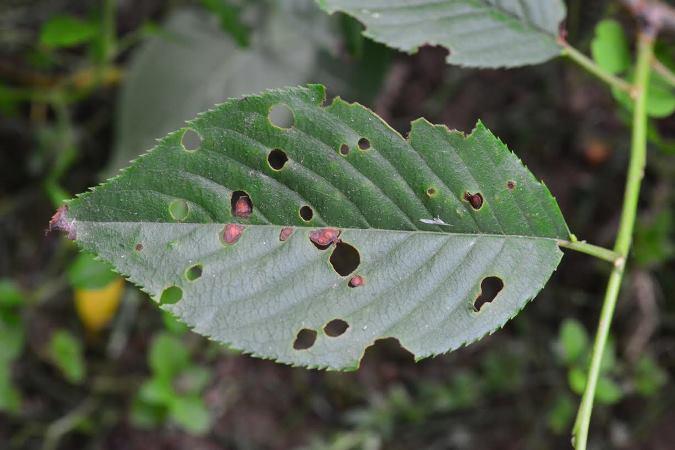About cherry shot hole disease
- Cherry shot-hole disease is a "catch-all" phrase referring to the symptom of tiny round holes (about ⅛” in diameter) in leaves of cherry trees and cherry laurel shrubs (Prunus spp.).
- The two pathogens that commonly produce these symptoms are bacterial leaf spot caused by the bacterium Xanthomonas pruni and cherry leaf spot caused by the fungus Blumeriella jaapii.
- Both diseases are favored by warm, wet spring weather.

Cherry leaf spot symptoms. Photo: David L. Clement, University of Maryland
Symptoms of cherry shot hole
- Foliar symptoms begin in the spring as brown or reddish-brown leaf spots. Later in the season, the infected leaf tissue drops out, leaving small “shot holes.”
- Infected cherry tree leaves will turn completely yellow and drop from the trees in mid-summer if the infection is severe. Defoliation can be dramatic in some years when disease pressure is high, but it is not lethal to the plant if the tree is otherwise healthy.
- On cherry laurel shrubs, the leaves with holes remain on the plant. New growth in the spring will hide the damaged leaves.
- These diseases will continue to infect leaves throughout the growing season if rainy weather persists.

Photo: Ask Extension
Management
- Remove older, heavily damaged, or poorly growing cherry trees. Plant resistant varieties such as Prunus 'First Lady' or Prunus 'Dream Catcher.'
- Try to adjust tree and shrub spacing and use proper pruning to provide better air circulation to promote faster leaf drying.
- Remove and dispose of fallen leaves in the fall to reduce overwintering pathogens.
- In most cases, trees and shrubs recover from these diseases and no treatment is necessary.
- On cherry laurel shrubs, prune out and discard symptomatic foliage.
- On high-value cherry trees or trees with a history of severe fungal leaf spot disease, the use of fungicides may help. But, fungicides will not work if the leaf spot is caused by the bacterium, Xanthomonas pruni. However, treatments will only provide preventative disease management or slow down the rate of disease development and will not cure already infected leaves.
- Fungicide applications would have to start as the new leaves are expanding and continue while rainy periods persist. A practical approach might be to apply two sprays, just as leaves are expanding and again when new leaves have reached full size. This approach will reduce the amount of disease and could give extended control in typical years. If you decide you want to manage this disease on cherry trees using a fungicide, contact a licensed arborist.
Additional resource
The Ohio State University Buckeye Yard and Garden Line | Late Season Ornamental Cherry Defoliation
Author: Dave Clement, Ph.D., Extension Specialist, Plant Pathology
Still have a question? Contact us at Ask Extension.
 English
English العربية
العربية Български
Български 简体中文
简体中文 繁體中文
繁體中文 Hrvatski
Hrvatski Čeština
Čeština Dansk
Dansk Nederlands
Nederlands Suomi
Suomi Français
Français Deutsch
Deutsch Ελληνικά
Ελληνικά हिन्दी
हिन्दी Italiano
Italiano 日本語
日本語 한국어
한국어 Norsk bokmål
Norsk bokmål Polski
Polski Português
Português Română
Română Русский
Русский Español
Español Svenska
Svenska Català
Català Filipino
Filipino עִבְרִית
עִבְרִית Bahasa Indonesia
Bahasa Indonesia Latviešu valoda
Latviešu valoda Lietuvių kalba
Lietuvių kalba Српски језик
Српски језик Slovenčina
Slovenčina Slovenščina
Slovenščina Українська
Українська Tiếng Việt
Tiếng Việt Shqip
Shqip Eesti
Eesti Galego
Galego Magyar
Magyar Maltese
Maltese ไทย
ไทย Türkçe
Türkçe فارسی
فارسی Afrikaans
Afrikaans Bahasa Melayu
Bahasa Melayu Kiswahili
Kiswahili Gaeilge
Gaeilge Cymraeg
Cymraeg Беларуская мова
Беларуская мова Íslenska
Íslenska Македонски јазик
Македонски јазик יידיש
יידיש Հայերեն
Հայերեն Azərbaycan dili
Azərbaycan dili Euskara
Euskara ქართული
ქართული Kreyol ayisyen
Kreyol ayisyen اردو
اردو বাংলা
বাংলা Bosanski
Bosanski Cebuano
Cebuano Esperanto
Esperanto ગુજરાતી
ગુજરાતી Harshen Hausa
Harshen Hausa Hmong
Hmong Igbo
Igbo Basa Jawa
Basa Jawa ಕನ್ನಡ
ಕನ್ನಡ ភាសាខ្មែរ
ភាសាខ្មែរ ພາສາລາວ
ພາສາລາວ Latin
Latin Te Reo Māori
Te Reo Māori मराठी
मराठी Монгол
Монгол नेपाली
नेपाली ਪੰਜਾਬੀ
ਪੰਜਾਬੀ Afsoomaali
Afsoomaali தமிழ்
தமிழ் తెలుగు
తెలుగు Yorùbá
Yorùbá Zulu
Zulu ဗမာစာ
ဗမာစာ Chichewa
Chichewa Қазақ тілі
Қазақ тілі Malagasy
Malagasy മലയാളം
മലയാളം සිංහල
සිංහල Sesotho
Sesotho Basa Sunda
Basa Sunda Тоҷикӣ
Тоҷикӣ O‘zbekcha
O‘zbekcha አማርኛ
አማርኛ Corsu
Corsu Ōlelo Hawaiʻi
Ōlelo Hawaiʻi كوردی
كوردی Кыргызча
Кыргызча Lëtzebuergesch
Lëtzebuergesch پښتو
پښتو Samoan
Samoan Gàidhlig
Gàidhlig Shona
Shona سنڌي
سنڌي Frysk
Frysk isiXhosa
isiXhosa